3. organisms P4
1/117
There's no tags or description
Looks like no tags are added yet.
Name | Mastery | Learn | Test | Matching | Spaced |
|---|
No study sessions yet.
118 Terms
Carpel (female)
Consists of three main parts:
- Stigma: Sticky surface that catches pollen.
- Style: Tube that connects stigma to ovary; guides pollen to the ovules.
- Ovary: Contains ovules which becomes seeds after fertilization
Stamen (male)
Made up of two main parts:
- Anther: Produces pollen grains, each containing a generative cell (which forms sperm cells) and a tube cell (which forms pollen tube)
- Filament: A stalk that holds up the anther.
Pollination
- Process where pollen grains are transferred from the anther to the stigma of a flower
- Occurs on stigma of carpel
Process of pollination and fertilization
- The flower makes pollen (plant sperm) in the anther.
- Pollen lands on stigma
- Pollen grains geminate and tube cells form pollen tube
- Pollen tube grows from the stigma, down the style, to the ovary. It does this as a response to chemicals secreted by ovules.
- Generative cells divide mitotically to form sperm cells
- The sperm from the pollen joins with the egg in the ovule, through the micropyle, forming a zygote
What happens straight after fertilization?
- Zygote divides mitotically to form the embryo
- Triploid cell develops into endosperm which nourishes the embryo
- The wall of the ovule becomes the seed coat, enclosing the embryo and endosperm
- The ovule begins to develop into a seed.
- The ovary starts to change into a fruit, which will protect the seed.
Differentiate fertilization in animals vs plants
- Location: Ovule (plants) VS. fallopian tube or externally in water or land (animals)
- Plants have double fertilization (forming a zygote and endosperm)
- Animals have single fertilization (only a zygote forms)
Draw and label diagram of the parts of an insect pollinated flower
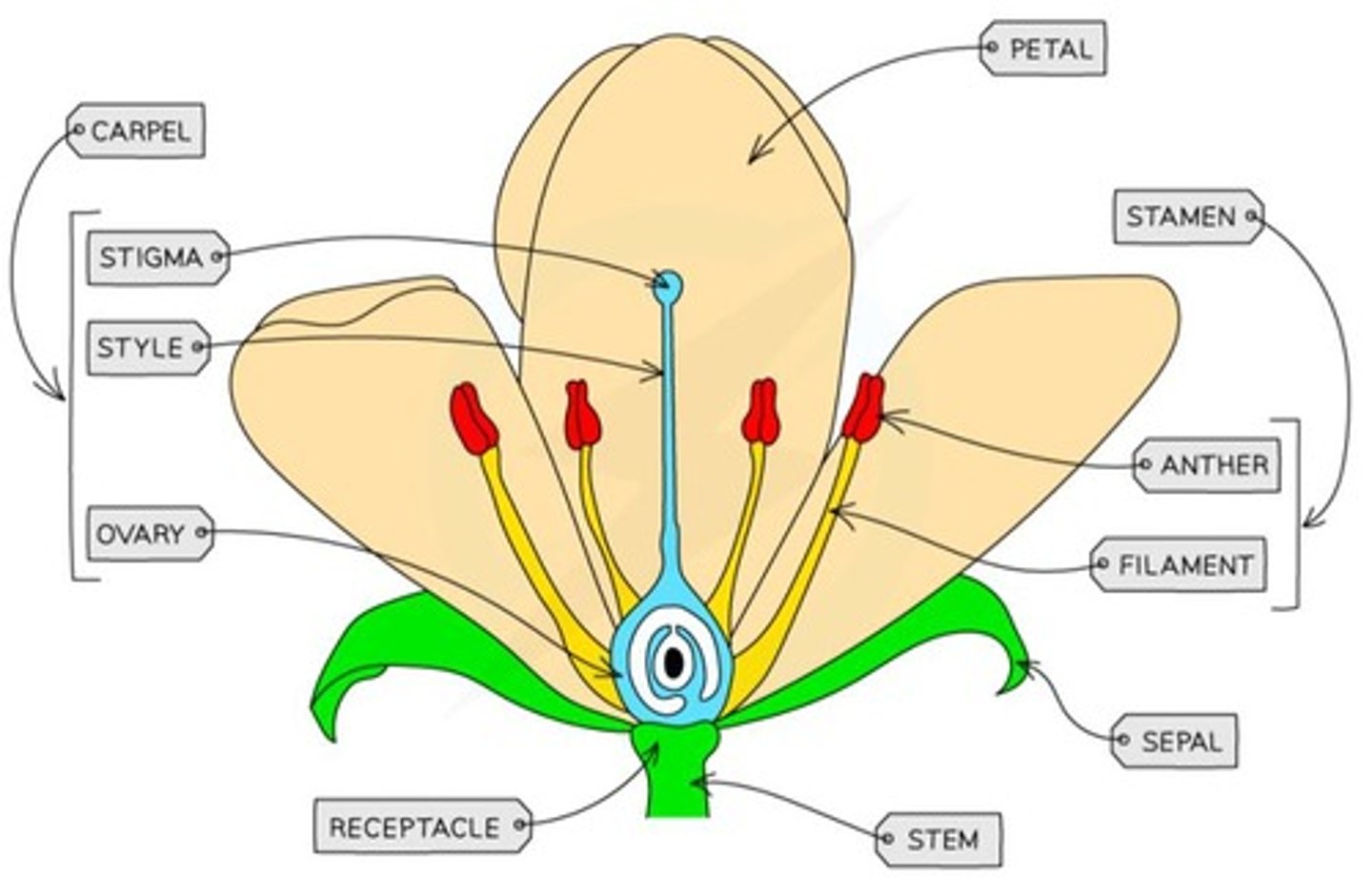
Petals
attract pollinators with bright colours and scent
Sepals
Protect the flower bud before it blooms
Anthers
Produce and release pollen grains
Filaments
Support anther and position it for effective pollen transfer
Stigma
Recieves pollen during pollination
Style
Supports stigma and provides a pathway for pollen tubes to reach ovary
Ovary
A flower structure that encloses and protects ovules and seeds as they develop.
Ovules
Contains a female gamete and develops into a seed after fertilization
self-pollination
the transfer of pollen grains from an anther to the stigma of the same flower or to the stigma of another flower on the same plant
cross-pollination
transfer of pollen grains from a flower on one plant to the stigma of a flower on another plant
Strategies for Cross-Pollination in Plants
- Male and female parts located on different plants
- Male and female parts maturing at different times to prevent self pollination
- Anatomical structure: plants can have different lengths of stamens and styles making self pollination difficult
- Self- incompatibility: genetic mechanisms preventing self-pollen from fertilizing the ovule, ensuring only genetically different pollen suceeds.
Role of Self-Incompatibility Mechanisms in Increasing Genetic Variation
- Self-incompatibility prevents a plant from fertilizing itself.
- Some genes with multiple alleles prevent pollen with the same allele from germinating.
- Allows the mixing of genes from different plants.
Methods of seed dispersal
Wind: Lightweight seeds are carried by the wind. They must also have adaptations like wings or hair to help them.
Water: Seeds must be buoyant or have structures like fibrous coverings, to help them float and are carried by water.
Animals: Animals may carry seeds externally or disperse seeds after eating fruits (excretion)
Germination
Process where a seed develops into a seedling (starts to grow into a new plant).
Conditions needed for a seed to germinate
- Water: hydrates the seed and activates metabolic reactions
- Favorable temperature: most seeds germinate best between 25°C and 30°C.
- Oxygen: Needed for cellular respiration and other metabolic activities of the growing embryo
Process of germination
- Germination starts when the seed is in a suitable environment (right temperature, water, and oxygen).
- The seed absorbs water, causing it to swell.
- The seed coat breaks open, and the embryo plant (radicle and shoot) grows.
- The root grows downwards to anchor the plant.
- The shoot grows upwards towards light to start photosynthesis.
sexual reproduction
- Involves the fusion of male and female gametes, resulting in offspring that are genetically different from the parents.
Asexual reproduction
- Does not involve gamete fusion and produces offspring that are genetically identical to the parent.
Differences between asexual and sexual reproduction
Parents: One (asexual) vs Two (sexual)
Offspring: Genetically identical (asexual), similar but not genetically identical to parents (sexual)
Genetic variation: No genetic variation in asexual, sexual leads to genetic variation (fusion of 2 haploid gametes)
Speed: Asexual is usually faster; sexual takes more time
Adaptability: asexual is efficient in stable environments, but less able to adapt to changes; sexual is genetically diverse, increasing adaptability and survival in changing environments
Fertiisation
Fusion of male and female gametes
Role of meiosis in creating variation
- Crossing over: exchange of genetic material between homologous chromosomes
- Independent assortment: Random distribution of chromosomes into gametes
- Creates genetically unique gametes → variation in offspring
Importance of mixing up parental gene combinations in meiosis
- Leads to new combinations of genes in each chromosome
- Increases genetic variation
- Gametes with many different variations in the homologous chromosomes are formed.
Draw a diagram of the male reproductive system

Testis
Produce sperm and testosterone
scrotum
A bag of skin that holds and protects the testicles (testis).

Epididymis
Highly coiled tubes where sperm mature and are stored
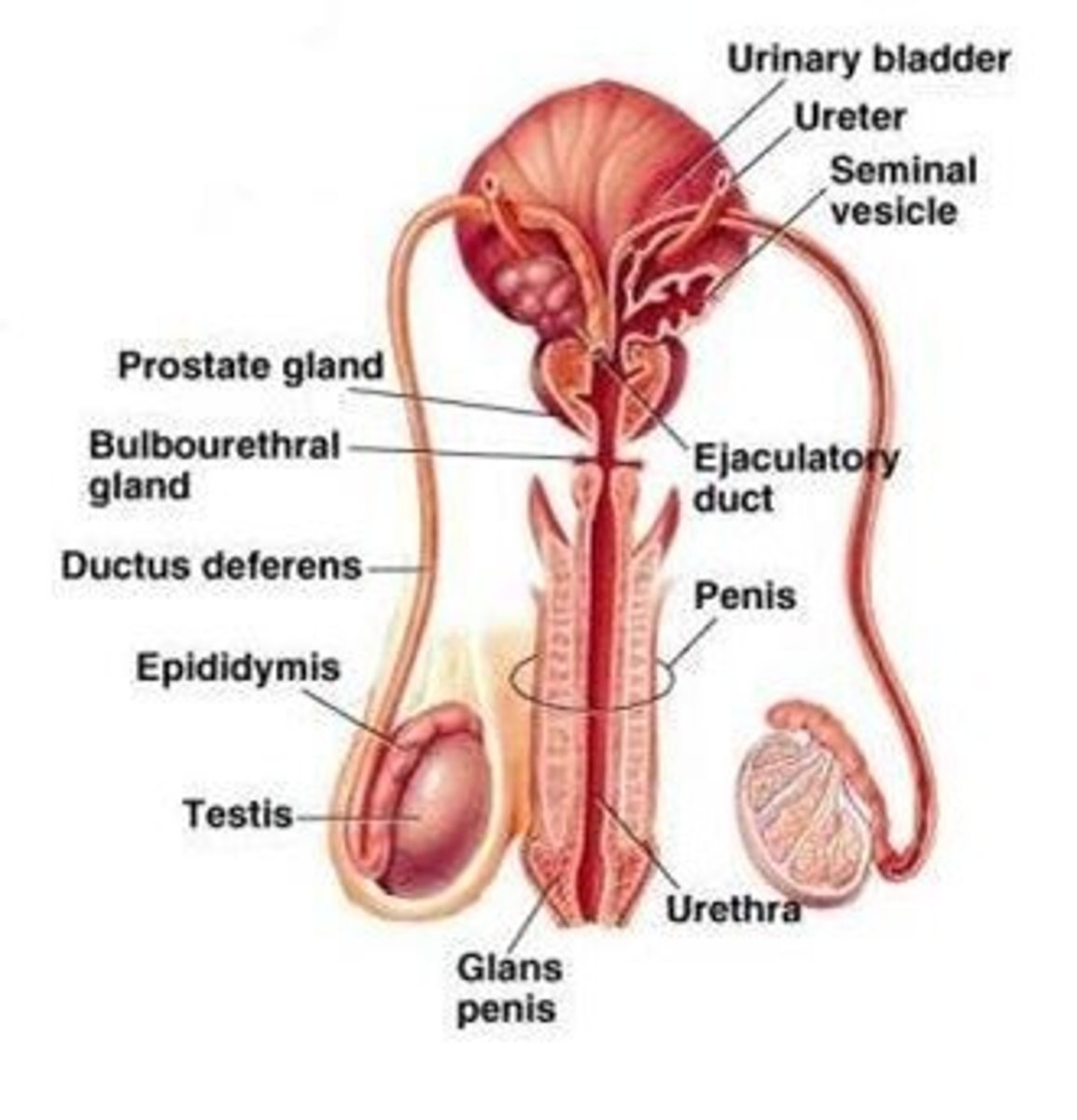
Sperm duct (vas deferens)
Transports mature sperm to the urethra in preparation for ejaculation.
Seminal Vesicles and prostrate gland
Produce fluids that helps in the transport and nourishement of sperm. This is alkaline fluid is refered to as semen.

Penis
Penetrates female vagina during intercourse, transferring sperm.
Urination
Urethra
the tube that carries urine & semen out of the body
Draw a diagram of the female reproductive system

Ovary (female)
Produce eggs and the female hormones: oestradiol and progesterone
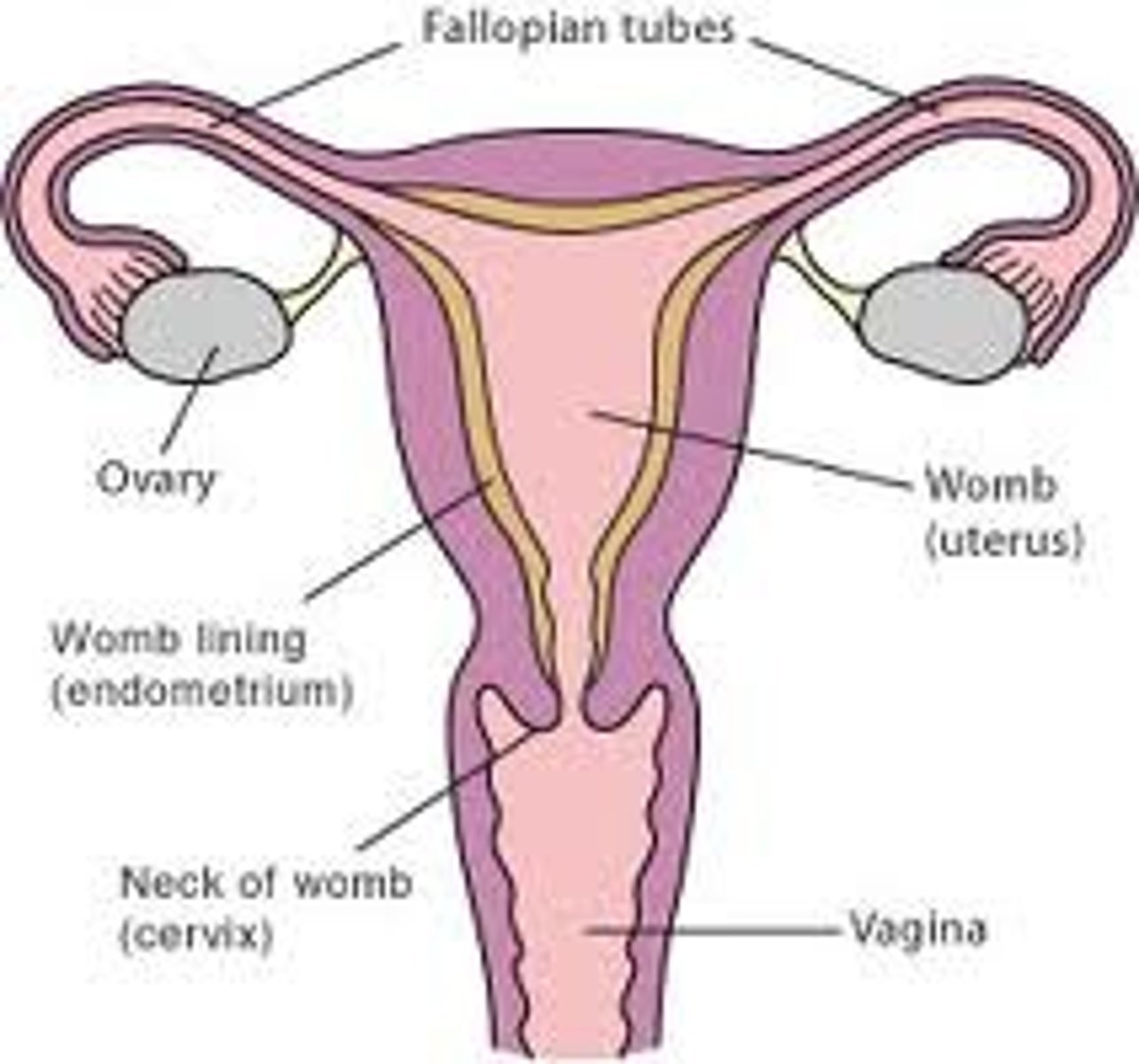
oviduct (fallopian tube)
Tube through which the eggs travel from the ovaries to uterus.
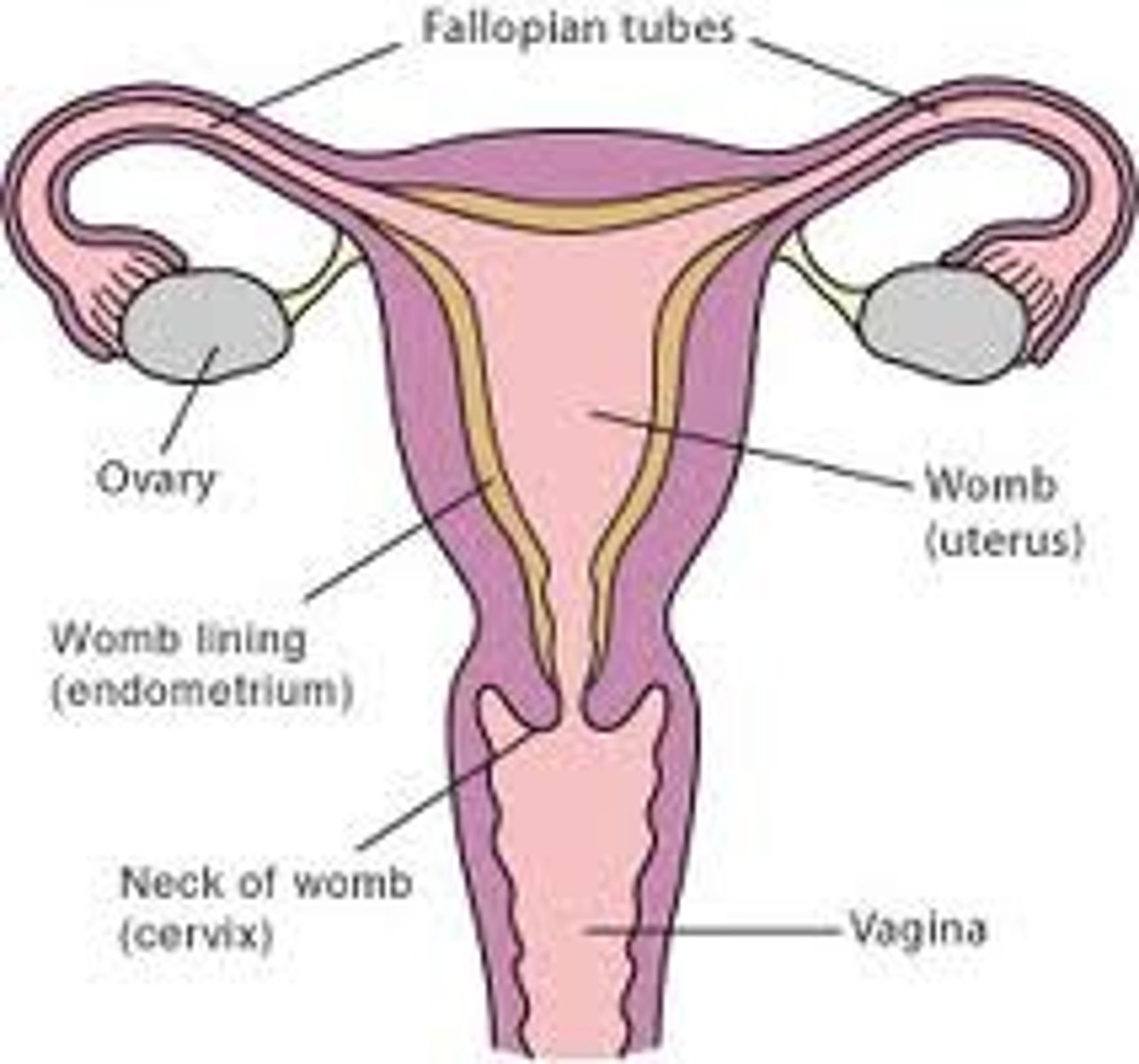
Uterus
Nourished the developing foetus till birth

Cervix
Opening of the uterus that allows fluids (such as menstrual blood or sperm) to flow in and out of the uterus.
Lower part of uterus.
Expands & contracts during childbirth.
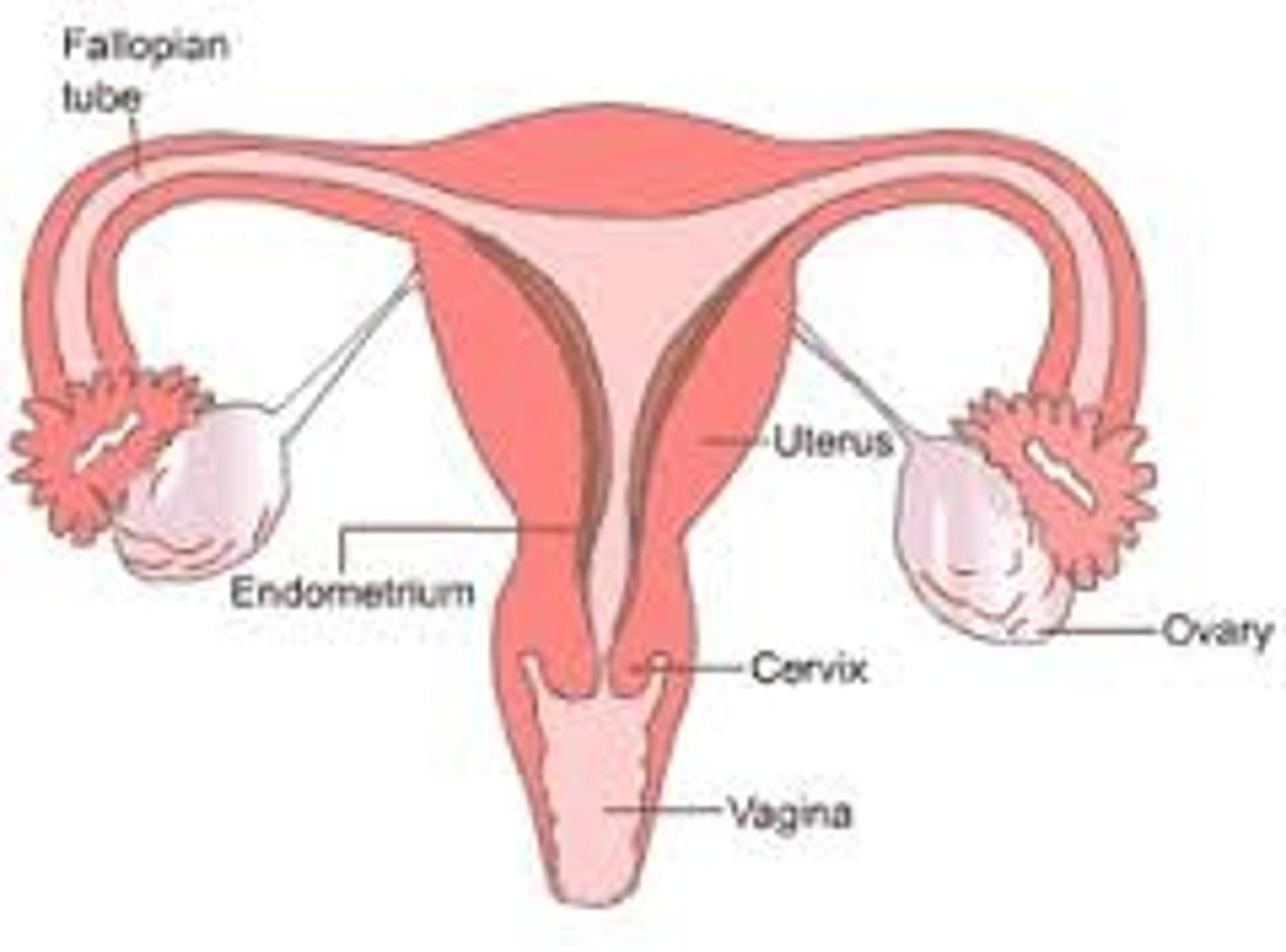
vagina
A muscular canal that extends from the cervix to the outside of the body
Vulva
protects the internal reproductive organs, facilitates sexual intercourse, urination and childbirth
Ovarian cycle
follicular phase, ovulation, luteal phase
uterine cycle
Proliferative phase, secretory phase, menstruation
Menstruation (Day 1-5)
- Low levels of estrogen and progesterone trigger the degeneration of the corpus luteum.
- The low hormone levels cause the shedding of the endometrial lining (menstruation).
Follicular phase/Proliferative phase (Day 6-14)
Follicular phase:
- Begins with menstrual flow (bleeding)
- FSH stimulates ovarian follicle development in the ovary
- The growing follicle produces oestrogen.
Proliferative phase
- Estrogen causes the endometrium to thicken in preparation for a potential pregnancy.
Ovulation (Day 14)
The LH surge triggers ovulation (release of the egg).
Luteal phase /Secretory phase (Day 14-28)
Luteal phase:
- LH and FSH levels drop. The ruptured follicle forms the corpus luteum, which secretes progesterone and oestradiol.
Secretory phase:
- Progesterone from the corpus luteum maintains and further thickens the endometrial lining.
- Prepares uterus for potential implantation of a fertilized egg.
Oestradiol (a form of estrogen)
- Stimulates the thickening of the endometrium (uterine lining)
- Inhibits FSH (prevents multiple follicles from developing).
- At high levels, it triggers a surge in LH, causing ovulation.
Progesterone
- Maintains the uterine lining for possible implantation.
- Inhibits FSH and LH to prevent new follicle development.
- Its drop triggers menstruation
LH
- Stimulates ovulation (egg release).
- Stimulates the formation of the corpus luteum.
FSH
- Stimulates the growth of ovarian follicles
- Stimulates oestradiol production from follicles.
Fertilization
1. Sperm comes into contact with the egg in the oviduct
2. The sperm undergoes capacitation and releases enzymes from its acrosome to penetrate the zone pellucida
3. The sperm binds with the plasma membrane of the oocyte
4. The plasma membrane of the sperm fuses with the plasma membrane of the egg, triggering egg activation. This blocks other sperm from entering the egg.
5. The sperm nucleus enters the egg
6. The sperm nucleus undergoes changes to form the male pronucleus (haploid)
7. The male pronucleus binds to the female pronucleus to form the diploid zygote.
Afterwards, the zygote undergoes mitotic division.
Hormone levels during menstural cycle
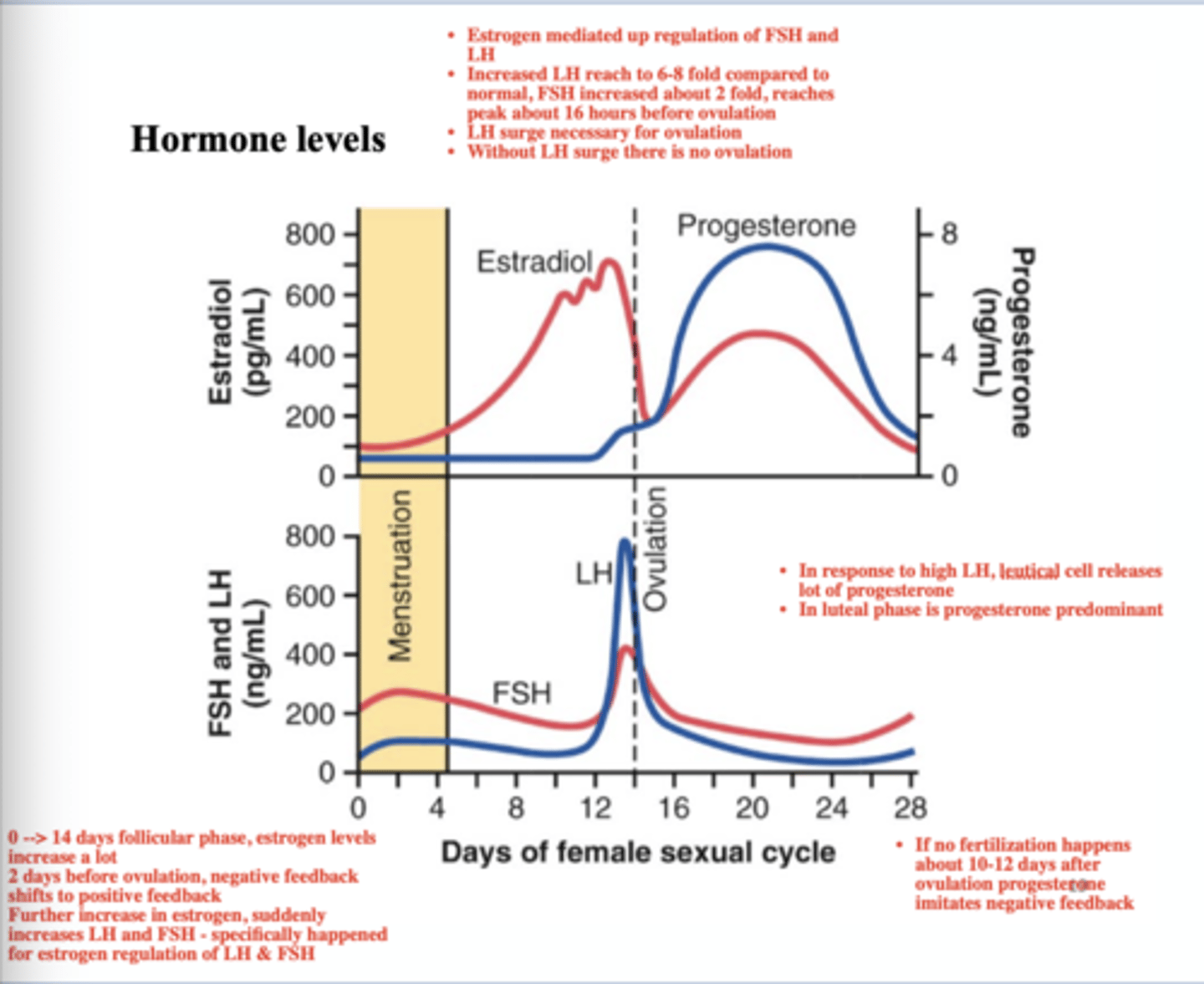
IVF treatment
1. Menstural cycle is suppressed for 2 weeks using medication
2. Fertility drugs with FSH stimulate multiple follicles, increasing number of eggs produced
3. An HCG (with LH) injection matures the follicles, and before they rupture, eggs are colleced using follicular aspiration
4. Eggs are placed in a petridish with donor sperm. After 16-18 hours, sample is checked for fertilization
5. Fertilized eggs grow in a culture medium
6. Healthy embryos are selected and transferred to the uterus on day 3 or day 5 for implantation
7. A pregnancy test is done 2 weeks later to confirm success
Why are natural hormones suppressed in IVF?
Ensures ovulation is controlled: allowing doctors to time egg collection and avoid premature/late release of eggs.
What is a diploid cell?
a nucleus which has chromosomes organised into pairs of homologous chromosomes
has 2 copies of each autosomal gene
Haploid cells
cells where the chromosomes dont come in pairs but only have a single chromosome in each pair.
zygote
formed when two haploid nuclei fuse together, matching up their chromosomes into pairs
Mendels experiment
1865, Gregor mendel published the results of his experiments on how garden pea plants pass on their characteristics
How did Mendels experiment work
he used artificial pollination techniques
to get sperm cells in pollen of pea plants into the ovum cells inside the ovaries of other pea plants
he cut off the anthers of plants to prevent self pollination and transferred pollen from some plants over to other plants
P generation
parental generatuon prduced in a TT tt cross
F1 generation
generation produced by the p generation
F2 generation
crossing 2 members of the F1 generation
self pollination
some plants have flowers that produce both male pollen and female ova
when a plants pollen lands on a flower it has produced itself
this will result in less genetic diversity
What can self pollination be used for
when farmers want uniform plants with the same characteristics.
Dominant allelle
an allele which has the same effect on the phenotype whether its paired with the same allele or not
recessive allele
allele which has an affect on the phenotype when theres no dominant allele present to mask it
codominant allele
pairs of alleles which both affect the phenotype when present in a heterozygote
what is phenotypic plasticity
the ability of an organism to express its phenotype diffrently depending on the environment
a way of adapting
can generate changes in physiology, morphology and behaviour.
Example of phenotypic plasticity
bids can activate genes that produce more of the digestive enzymes when there are more grains in their diet
phenological
cyclical events like food availability
genotype
symbolic representation of the pair of alleles possessed by an organism.
homozygous
refers to having 2 identical alleles of a gene
heterozygous
refers to having 2 different alleles of a gene
phenotype
is the observable characteristics or traits of an organism
phenotypes exclusively dependent on genotype
blood type
genetic conditions.
phenotypes not exclusively dependent on genotype
muscle mass
learned behaviour
acquired traits
phenylketonuria
caused by mutations in the autosomal PAH gene, which results in low levels of the enzyme phenylalanine hydroxylase.
What does the enzyme do?
converts the amino acid phenylalanine into tyrosine which is not toxic
if theres large amounts of protein in a childs diet, phenylalanine levels can become toxic and impair development
Autosomal recessive alleles
caused by recessive alleles, and the locus of their gene is found on 1 of the first 22 paris of chromosomes and not teh sex chromosomes
Example of autosomal conditions
sickle cell, cystic fibrosis
SNP
occur when a single nucleotide of the genetic code, like T, is not found where it is expected but some other base like C is found in its place.
what does the SNP indicate
it indicates a different allele
incomplete dominance
the phenotype is a mix of the 2 parents and each allele contributes to the characteristic, neither one is masked.
difference between X and Y chromosome
The X chromosome is longer therefore contains more genes
50% of either being boy or girl
Y chromosoem is significantly smaller so it has less loci and carries fewer genes
Sex linked trait
any genetic trait that has a gene locus on the X or Y chromosome
Haemophilia
disorder where blood doesn’t clot and scab properly so when people with the condition get relatively minor injuries they are at risk of bleeding out.
Huntingtons disease
causes debilitating nerve damage and difficulty walking and remembering things
caused by a dominant allele
why is it discouraged for close relatives to have kids together
rare diseases are rare among the general population but much more frequent among close relatives.
unfavourable traits or conditions are produced at higher frequencies when close relatives have kids.
polygenic inheritance
involves 2 or more genes influencing the expression of one trait
with 2 or more allelic pairs found at different loci, the number of possible genotypes is greatly increased.
segregation
seperation of alleles during meiosis
independent assortment
segregation of alleles in a way that the inheritance of one does not influence the other.
linkage genes
any 2 genes which are found on the same chromosomes and are usually passed onto the next generation together
linkage group
a group of genes inherited together because they are found on the same chromosome.
homeostasis
regulatory mechanisms to keep certain physiological factors within preset limits
Examples of factors maintained by homeostasis
internal body temp
blood ph
blood glucose concentration
negative feedback mechanisms
physiological processes that bring a value back to a set point
main function: to keep a value within the narrow range which is considered normal.